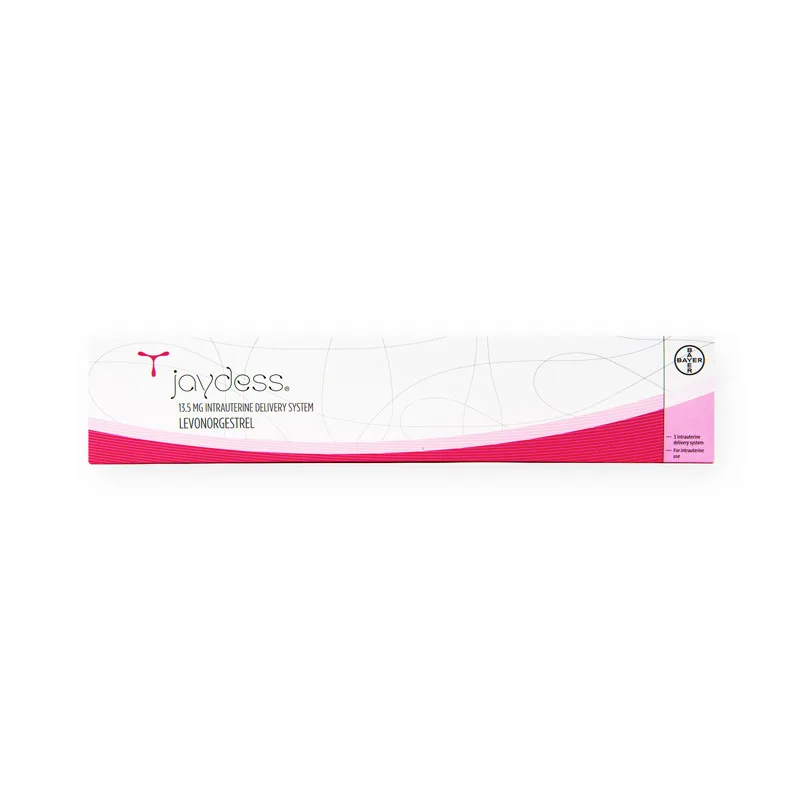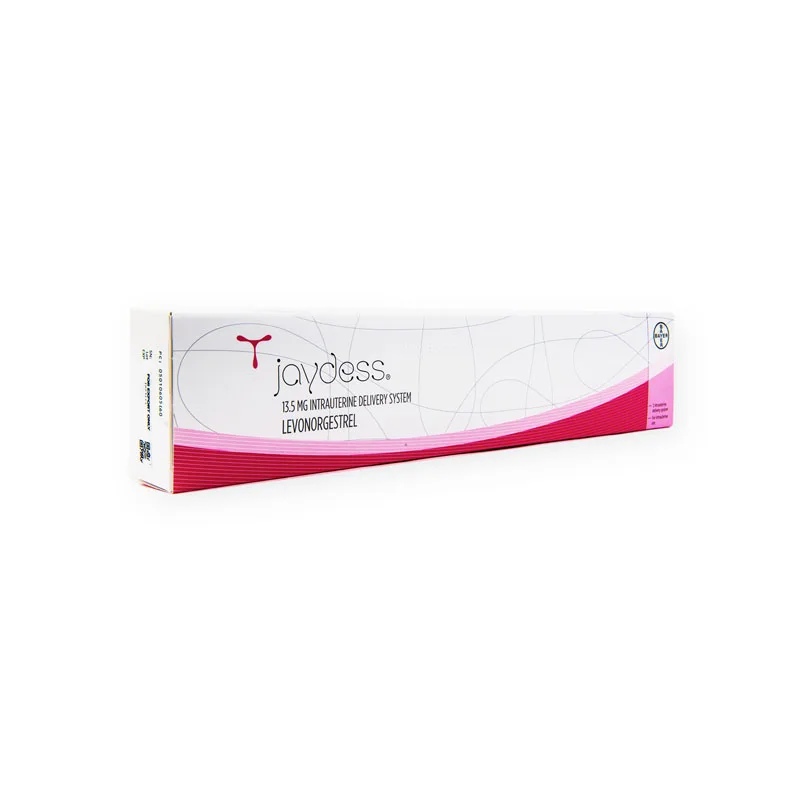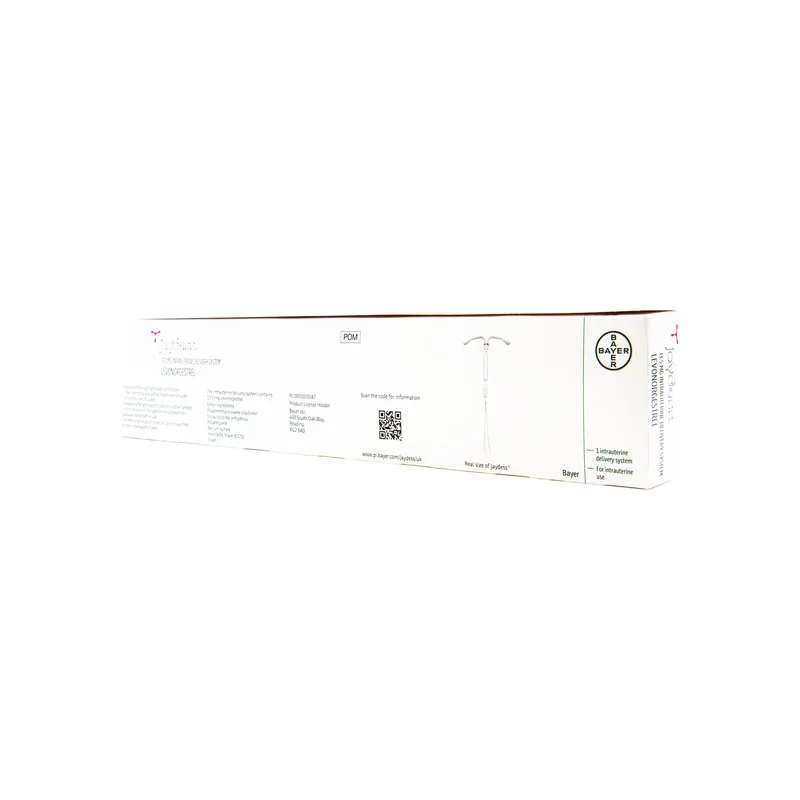
Manufacturer: Bayer
Active Substance(s): LEVONORGESTREL
Strength: 13.5mg per IUS
Pack Size: 1 IUD
Jaydess is used for the prevention of pregnancy (contraception) for up to three years. Jaydess is a T-shaped intrauterine delivery system (IUS) which after placement inside the womb slowly releases a small amount of the hormone levonorgestrel.
Jaydess works by reducing the monthly growth of the lining of the womb and thickening the cervical mucus. These actions prevent the sperm and egg from coming into contact and so prevent fertilization of an egg by sperm.
INFORMATION
JAYDESS® Product Description
JAYDESS® is a levonorgestrel-releasing intrauterine delivery system (IUS) designed for long-term contraceptive use. Its T-shaped polyethylene frame carries 13.5 mg of levonorgestrel, gradually released into the uterus over three years. The device prevents pregnancy by controlling endometrial development, thickening cervical mucus, and interfering with sperm motility, thereby contributing to overall reproductive health. This information helps patients weigh the side effects and benefits of Jaydess for their health.
Key components of Jaydess are:
- Active Ingredient: 13.5 mg levonorgestrel.
- Inactive Ingredients: Dimethylsiloxane/methylvinylsiloxane elastomer, colloidal anhydrous silica, polyethylene, barium sulfate, and iron oxide.
JAYDESS® Key Features and Benefits
This intrauterine system provides effective contraception with minimal maintenance:
- Long-lasting: Jaydess is effective for up to three years.
- Highly reliable: Published studies indicate that Jaydess is 99% effective in preventing pregnancy.
- Convenience: Jaydess does not require daily dosing.
- Minimal systemic impact: Hormone release localized to the uterus, supporting overall reproductive health.
- Gradual hormone release: 6 micrograms per day initially, declining over time.
JAYDESS® Indications and Treatment Applications
JAYDESS® is indicated for women seeking long-term reversible contraception. Jaydess is ideal for:
- Women with no contraindications to levonorgestrel or intrauterine devices.
- Nulliparous and multiparous women looking for non-permanent contraception.
- Women prefer low-maintenance contraception.
JAYDESS® Dosage and Administration
JAYDESS® is inserted into the uterus by a doctor:
- Insertion timing: Doctors preferably insert Jaydess within seven days of the menstrual cycle onset or six weeks postpartum.
- Placement procedure: Conducted after a doctor has performed a gynecological assessment, including pelvic and cervical examinations.
- Removal: Jaydess should be replaced or removed after three years.
JAYDESS® Side Effects and Warnings
JAYDESS® may cause side effects, most commonly during the first months after insertion:
- Common Side Effects:
- Irregular menstrual bleeding (spotting, heavier or lighter periods).
- Abdominal pain, headaches, and acne.
- Serious Risks:
- Pelvic inflammatory disease (PID) or uterine perforation during insertion.
- Ectopic pregnancy in rare cases of contraceptive failure.
- Expulsion of the device.
JAYDESS® Precautions and Contraindications
Jaydess is not suitable for all women. Doctors have noted that contraindications include:
- Current or recurrent pelvic infections.
- Known or suspected pregnancy.
- Progestogen-sensitive tumors, liver diseases, or uterine abnormalities.
- Unexplained vaginal bleeding or untreated genital infections.
Doctors raise caution for women with the following conditions:
- Congenital or valvular heart disease, migraines with visual symptoms, or a history of blood clots.
- Increased STI risk, as infections can impact device efficacy and safety.
JAYDESS® Long-Term Considerations
Regular follow-ups with a doctor are essential to ensure that Jaydess remains effective and to monitor for complications:
- Check-ups: First at 4-12 weeks post-insertion, then annually.
- Fertility: Normal fertility resumes quickly after removal.
- Osteoporosis Risk: Side effects like this are not directly associated but should be monitored by doctors in long-term hormonal contraceptive users.
JAYDESS® Manufacturer and Regulatory Information
The following information regarding Jaydess’ manufacturer lets doctors and patients know more about the device.
- Manufacturer: Bayer New Zealand Limited.
- Approval: Complies with international contraceptive device standards.
- Storage: Keep below 30°C in a dry environment; avoid heat and humidity.
JAYDESS® FAQs
Here’s a list of frequently asked questions:
What happens if the device is expelled?
Contact your doctor immediately. Use alternative contraception until a replacement is placed.
Can JAYDESS® affect periods?
Yes, many users experience spotting or irregular bleeding initially. Over time, some women may experience lighter periods or amenorrhea.
Is JAYDESS® safe for breastfeeding women?
Yes, the hormone released is minimal and does not harm the baby.
What should I do if I suspect pregnancy?
Seek immediate medical attention. Ectopic pregnancies, while rare, require urgent care.
Can I use JAYDESS® to prevent sexually transmitted infections (STIs)?
No, additional protective measures, like condoms, are needed to prevent STIs.
JAYDESS® Product Description
JAYDESS® is a levonorgestrel-releasing intrauterine delivery system (IUS) designed for long-term contraceptive use. Its T-shaped polyethylene frame carries 13.5 mg of levonorgestrel, gradually released into the uterus over three years. The device prevents pregnancy by controlling endometrial development, thickening cervical mucus, and interfering with sperm motility, thereby contributing to overall reproductive health. This information helps patients weigh the side effects and benefits of Jaydess for their health.
Key components of Jaydess are:
- Active Ingredient: 13.5 mg levonorgestrel.
- Inactive Ingredients: Dimethylsiloxane/methylvinylsiloxane elastomer, colloidal anhydrous silica, polyethylene, barium sulfate, and iron oxide.
JAYDESS® Key Features and Benefits
This intrauterine system provides effective contraception with minimal maintenance:
- Long-lasting: Jaydess is effective for up to three years.
- Highly reliable: Published studies indicate that Jaydess is 99% effective in preventing pregnancy.
- Convenience: Jaydess does not require daily dosing.
- Minimal systemic impact: Hormone release localized to the uterus, supporting overall reproductive health.
- Gradual hormone release: 6 micrograms per day initially, declining over time.
JAYDESS® Indications and Treatment Applications
JAYDESS® is indicated for women seeking long-term reversible contraception. Jaydess is ideal for:
- Women with no contraindications to levonorgestrel or intrauterine devices.
- Nulliparous and multiparous women looking for non-permanent contraception.
- Women prefer low-maintenance contraception.
JAYDESS® Dosage and Administration
JAYDESS® is inserted into the uterus by a doctor:
- Insertion timing: Doctors preferably insert Jaydess within seven days of the menstrual cycle onset or six weeks postpartum.
- Placement procedure: Conducted after a doctor has performed a gynecological assessment, including pelvic and cervical examinations.
- Removal: Jaydess should be replaced or removed after three years.
JAYDESS® Side Effects and Warnings
JAYDESS® may cause side effects, most commonly during the first months after insertion:
- Common Side Effects:
- Irregular menstrual bleeding (spotting, heavier or lighter periods).
- Abdominal pain, headaches, and acne.
- Serious Risks:
- Pelvic inflammatory disease (PID) or uterine perforation during insertion.
- Ectopic pregnancy in rare cases of contraceptive failure.
- Expulsion of the device.
JAYDESS® Precautions and Contraindications
Jaydess is not suitable for all women. Doctors have noted that contraindications include:
- Current or recurrent pelvic infections.
- Known or suspected pregnancy.
- Progestogen-sensitive tumors, liver diseases, or uterine abnormalities.
- Unexplained vaginal bleeding or untreated genital infections.
Doctors raise caution for women with the following conditions:
- Congenital or valvular heart disease, migraines with visual symptoms, or a history of blood clots.
- Increased STI risk, as infections can impact device efficacy and safety.
JAYDESS® Long-Term Considerations
Regular follow-ups with a doctor are essential to ensure that Jaydess remains effective and to monitor for complications:
- Check-ups: First at 4-12 weeks post-insertion, then annually.
- Fertility: Normal fertility resumes quickly after removal.
- Osteoporosis Risk: Side effects like this are not directly associated but should be monitored by doctors in long-term hormonal contraceptive users.
JAYDESS® Manufacturer and Regulatory Information
The following information regarding Jaydess’ manufacturer lets doctors and patients know more about the device.
- Manufacturer: Bayer New Zealand Limited.
- Approval: Complies with international contraceptive device standards.
- Storage: Keep below 30°C in a dry environment; avoid heat and humidity.
JAYDESS® FAQs
Here’s a list of frequently asked questions:
What happens if the device is expelled?
Contact your doctor immediately. Use alternative contraception until a replacement is placed.
Can JAYDESS® affect periods?
Yes, many users experience spotting or irregular bleeding initially. Over time, some women may experience lighter periods or amenorrhea.
Is JAYDESS® safe for breastfeeding women?
Yes, the hormone released is minimal and does not harm the baby.
What should I do if I suspect pregnancy?
Seek immediate medical attention. Ectopic pregnancies, while rare, require urgent care.
Can I use JAYDESS® to prevent sexually transmitted infections (STIs)?
No, additional protective measures, like condoms, are needed to prevent STIs.







